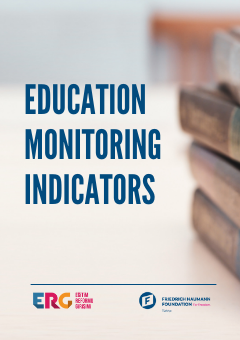Education in Turkey
Education Monitoring Indicators
The Education Monitoring Indicators booklet is one of the products of the FNF-funded
Education Data Literacy Summer School, which was held between August 12-14, 2020.
Since its inception in 2003, ERG has worked towards ensuring children’s right to quality
education by helping to create evidence-based policies. To serve this purpose, ERG has
been publishing Education Monitoring Reports since 2008, wherein quantitative data
acquired from various sources are turned into education indicators. This document
presents these indicators, which have been used by ERG to monitor education for the last
12 years, along with their data sources and calculation methods, and it provides an
overview of the changes that have been made to the education system over the course of
the last 13 years.
This document highlights key Education Monitoring Indicators, such as data on resources allocated for education and how these resources have changed over the years. Other indicators, including those employed by MoNE to monitor annual objectives, such as number of students per classroom or teacher, the percentage of private education institutions and net enrollment rates, are also found here. Region specific indicators are included, as they highlight regional differences in education. Moreover, indicators on youth who are not in employment, education or training and on the PISA study are included to enable comparison of Turkey’s education to that of OECD countries.
By publishing the Education Monitoring Indicators booklet, ERG aims to share the key indicators they have been using for monitoring education over the course of the last 12 years with the public and education shareholders and also to start a discussion on the adequacy of these indicators. Although the data and the indicators shared here provide essential information on Turkey’s education system, they nonetheless only provide a limited picture of the whole system, thus impairing a thorough monitoring and evaluation of the changes in education. Yet, it is possible to overcome this shortcoming by sharing more comprehensive and detailed data with the public, promoting data literacy skills, discussing the adequacy of the current indicators and creating new ones.
-

Download the whole booklet!